Insect and scorpion stings are a rare cause of mortality Mortality All deaths reported in a given population. Measures of Health Status. Hymenoptera insects and Centruroides scorpions can potentially lead to serious symptoms due to envenomation. Pain Pain An unpleasant sensation induced by noxious stimuli which are detected by nerve endings of nociceptive neurons. Pain: Types and Pathways, swelling Swelling Inflammation, erythema Erythema Redness of the skin produced by congestion of the capillaries. This condition may result from a variety of disease processes. Chalazion, and warmth are common at the site of a sting. Hymenoptera stings may lead to anaphylaxis Anaphylaxis An acute hypersensitivity reaction due to exposure to a previously encountered antigen. The reaction may include rapidly progressing urticaria, respiratory distress, vascular collapse, systemic shock, and death. Type I Hypersensitivity Reaction. Venomous scorpion stings can result in neurologic manifestations such as muscle spasms Spasms An involuntary contraction of a muscle or group of muscles. Spasms may involve skeletal muscle or smooth muscle. Ion Channel Myopathy; abnormal head, neck Neck The part of a human or animal body connecting the head to the rest of the body. Peritonsillar Abscess, and eye movements; excessive salivation; and diaphoresis. The diagnosis of insect and scorpion stings is clinical. Management of insect stings includes cleansing the wound, antihistamines Antihistamines Antihistamines are drugs that target histamine receptors, particularly H1 and H2 receptors. H1 antagonists are competitive and reversible inhibitors of H1 receptors. First-generation antihistamines cross the blood-brain barrier and can cause sedation. Antihistamines and pain Pain An unpleasant sensation induced by noxious stimuli which are detected by nerve endings of nociceptive neurons. Pain: Types and Pathways relievers, and treatment for anaphylaxis Anaphylaxis An acute hypersensitivity reaction due to exposure to a previously encountered antigen. The reaction may include rapidly progressing urticaria, respiratory distress, vascular collapse, systemic shock, and death. Type I Hypersensitivity Reaction. Scorpion stings may require close monitoring, supportive care, benzodiazepines Benzodiazepines Benzodiazepines work on the gamma-aminobutyric acid type A (GABAA) receptor to produce inhibitory effects on the CNS. Benzodiazepines do not mimic GABA, the main inhibitory neurotransmitter in humans, but instead potentiate GABA activity. Benzodiazepines for muscle spasms Spasms An involuntary contraction of a muscle or group of muscles. Spasms may involve skeletal muscle or smooth muscle. Ion Channel Myopathy, and antivenom.
Last updated: Dec 15, 2025
Insect stings:
Scorpion stings:
The Hymenoptera order includes the following stinging insects:
Venomous scorpions in the United States include:

European honey bee
Image: “European honey bee extracts nectar” by John Severns. License: Public Domain
The striped bark scorpion, Centruroides vittatus
Image: “16417” by CDC/ Margaret A. Parsons. License: Public Domain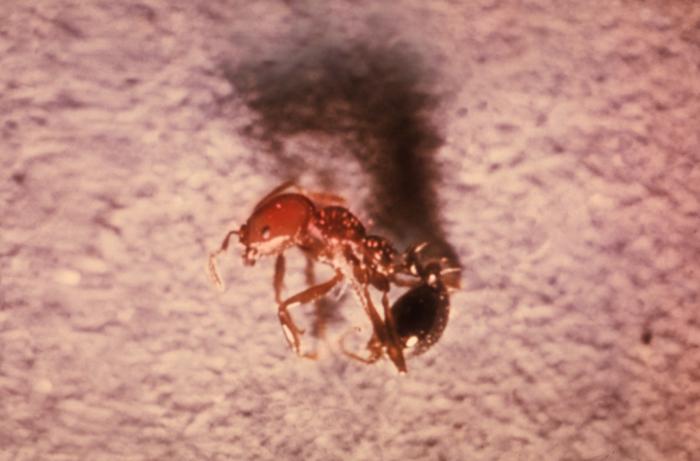
A red imported fire ant, Solenopsis invicta
Image: “4635” by CDC/ Margaret Parsons. License: Public DomainLocal signs and symptoms:
Systemic signs and symptoms ( anaphylaxis Anaphylaxis An acute hypersensitivity reaction due to exposure to a previously encountered antigen. The reaction may include rapidly progressing urticaria, respiratory distress, vascular collapse, systemic shock, and death. Type I Hypersensitivity Reaction):
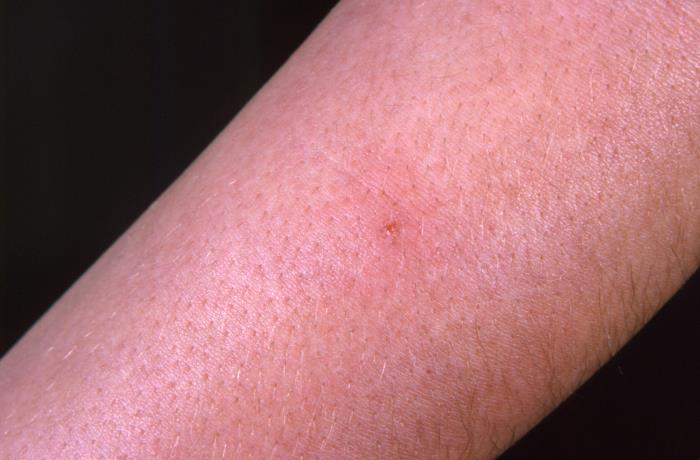
Erythema surrounding a wasp sting on a patient’s arm
Image: “21543” by CDC/Dr. Scott. License: Public Domain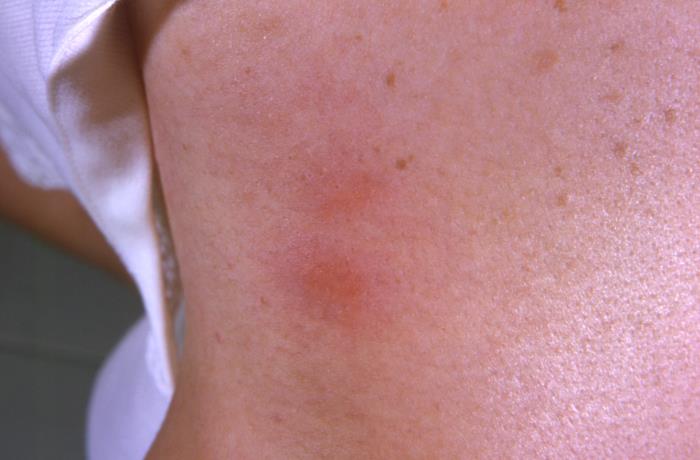
Localized erythema and swelling at the site of a wasp sting on a patient’s shoulder
Image: “21541” by CDC/Dr. Scott. License: Public Domain
Significant swelling of the dorsal surface of a woman’s right forearm and hand after having been stung by a yellow jacket:
Note the erythema around the site of the sting on the dorsum of the right hand.
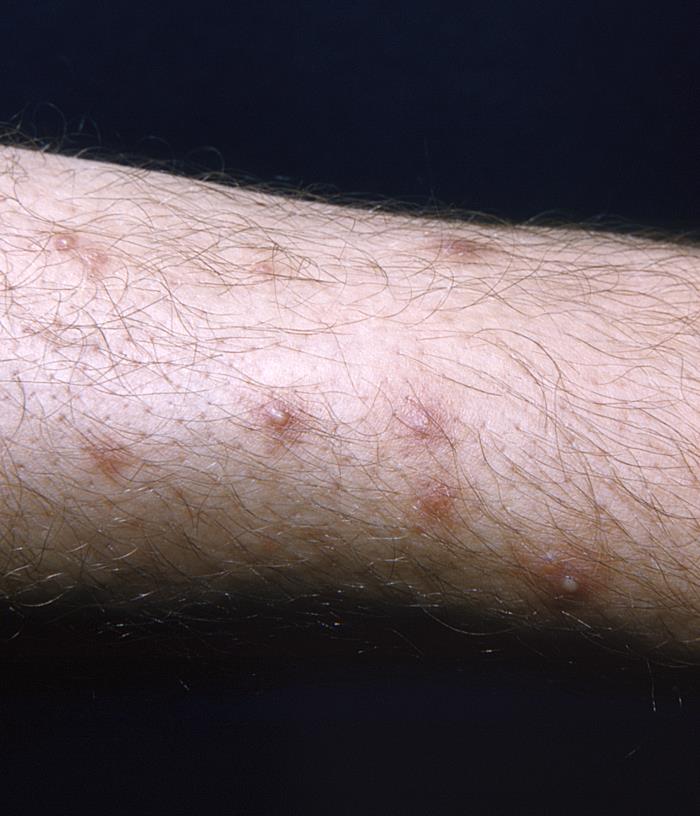
A number of pustular lesions caused by the bites of fire ants:
Note the erythematous ring, which surrounds the pustular center.
Local signs and symptoms:
Systemic signs and symptoms (envenomation):
Complications:
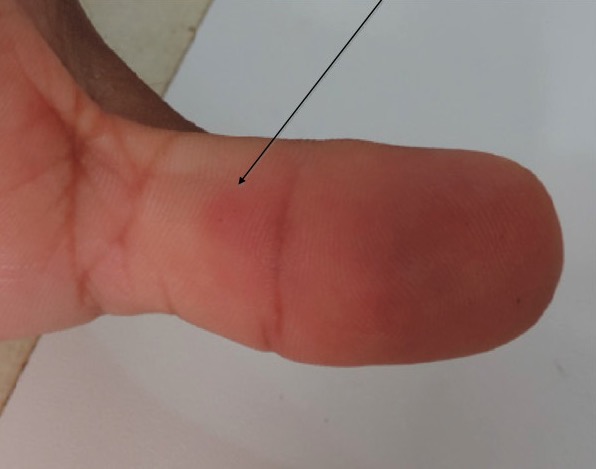
Scorpion sting site on a patient’s thumb
Image: “Scorpion sting site” by Laboratory of Chemistry and Biological Macromolecule Structure, Federal University of Western Pará (UFOPA), Santarém, Pará State Brazil. License: CC BY 4.0Insect and scorpion stings are clinical diagnoses.
General management:
Management of severe allergic reactions Allergic Reactions Type I hypersensitivity reaction against plasma proteins in donor blood Transfusion Reactions and anaphylaxis Anaphylaxis An acute hypersensitivity reaction due to exposure to a previously encountered antigen. The reaction may include rapidly progressing urticaria, respiratory distress, vascular collapse, systemic shock, and death. Type I Hypersensitivity Reaction:
Prevention:
Most stings only require supportive care. Care for venomous scorpions may include: